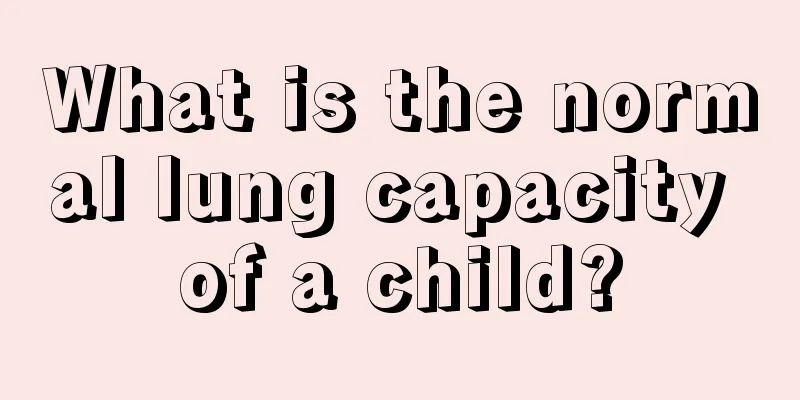What is the normal lung capacity of a child?

|
The health of every child is the most worrying issue for parents. In life, every child has different living habits and physical conditions. Many children always encounter some health problems during physical examinations. Among them, vital capacity is the simplest and most effective way to detect the development of children's lungs. However, since we know little about medical knowledge, we don't know what is a normal lung capacity for children. Let's take a look at what is a normal lung capacity for children. What is the normal lung capacity of a child? The normal value of vital capacity for 12-year-old children is 2200 ml for boys and 2076 ml for girls. Vital capacity refers to the total amount of gas exhaled after taking a deep breath. Vital capacity = tidal volume + inspiratory reserve volume + expiratory reserve volume. Tidal volume refers to the amount of gas inhaled or exhaled during each breath. Inspiratory reserve volume is also called inspiratory reserve volume, which refers to the amount of gas that can be inhaled after a quiet inhalation and then a strong inhalation. Expiratory reserve volume is also called expiratory reserve volume, which refers to the amount of gas that can be exhaled after a quiet exhalation and then a strong exhalation. Vital capacity is the maximum ventilation volume of one breath, which can reflect the potential capacity of respiratory function in a certain sense. The lung capacity of adult men is about 3500 ml, and that of women is about 2500 ml. The lung capacity of middle-aged people is the largest, while that of young and elderly people is smaller. The healthier the person, the greater the lung capacity. Lung tissue damage such as tuberculosis, pulmonary fibrosis, atelectasis or lobectomy to a certain extent may reduce the lung capacity; kyphosis, pleural thickening, exudative pleurisy or pneumothorax may also limit lung expansion and reduce lung capacity. Therefore, a significant reduction in lung capacity is a manifestation of restrictive ventilation disorder. Since the method of measuring vital capacity is simple and has good repeatability, it is a commonly used indicator for health checks. Since the vital capacity is measured without limiting the speed of exhalation, it cannot detect diseases of poor respiratory ventilation. Therefore, the timed vital capacity measurement method is more ideal as a dynamic indicator of lung function. Timed vital capacity is the fastest exhalation after maximum inhalation until the exhalation is complete. At the same time, the amount of air exhaled at the end of the 1st, 2nd, and 3rd seconds is recorded separately. A normal person should exhale 83%, 96%, and 99% of his vital capacity respectively. People with obstructive pulmonary disease often need 5 to 6 seconds or more to exhale all their vital capacity; in many pathological conditions where respiratory movement is limited, the timed vital capacity in the first second increases, and the entire vital capacity can be exhaled in advance. Therefore, timed vital capacity can be used as a reference for distinguishing obstructive or restrictive ventilation disorders. The above is an introduction to the normal lung capacity of children. After understanding it, we know that children's lung capacity is generally weaker than that of adults, but as long as it is within the normal range, we should not worry too much. In addition, children must be encouraged to develop the habit of exercising more, which can improve their body's immunity while also improving their lung capacity. |
<<: How to treat ringworm on a child's face?
>>: What is the cause of the child's right abdominal cramps?
Recommend
How to make noodles for one-year-old baby
We all know that as the baby grows day by day, th...
What should I do if my baby often has foot pain?
Foot pain is a very common phenomenon, especially...
How to improve children's memory
Every parent hopes that their baby is not only he...
What causes white spots on children's nails?
In fact, in daily life, we must pay attention to ...
New born baby girl bleeding
The body functions of a newborn baby girl are not...
Diet to prevent baby colds in summer
Summer has arrived. In this season you will find ...
Treatment of large gaps between baby's front teeth
The birth of every new life will make our parents...
What causes a child's stomach ache?
When children are young, it is easy for them to h...
What should I do if my child always doesn't like to eat?
Children’s health and development are the issues ...
The child suddenly has a lot of eye mucus
Every child is a treasure in the eyes of his or h...
What is the normal body temperature of a three-year-old baby?
Babies are the people in our lives who need our a...
What to do if your baby coughs after waking up
Children's bodies are relatively fragile, so ...
What should I do if my child's teeth become loose?
It is the nature of children to be playful and ac...
What causes precocious puberty in children?
For us conservative Chinese people, sex is a matt...
Can children’s myopia be cured? The correct method is effective!
The myopia problem in children is a matter of gre...









